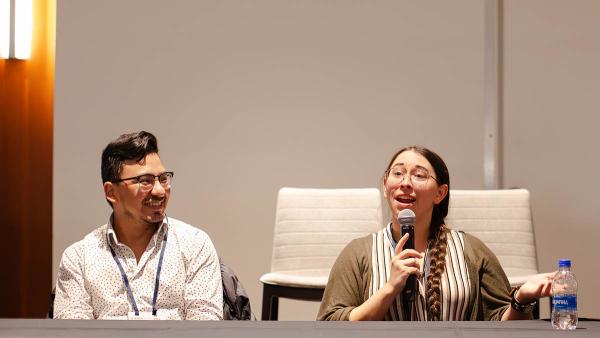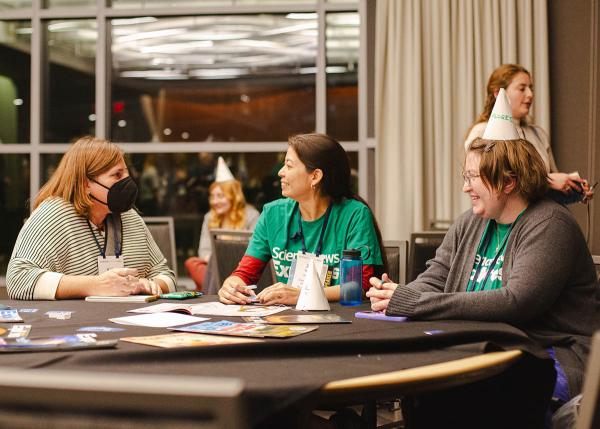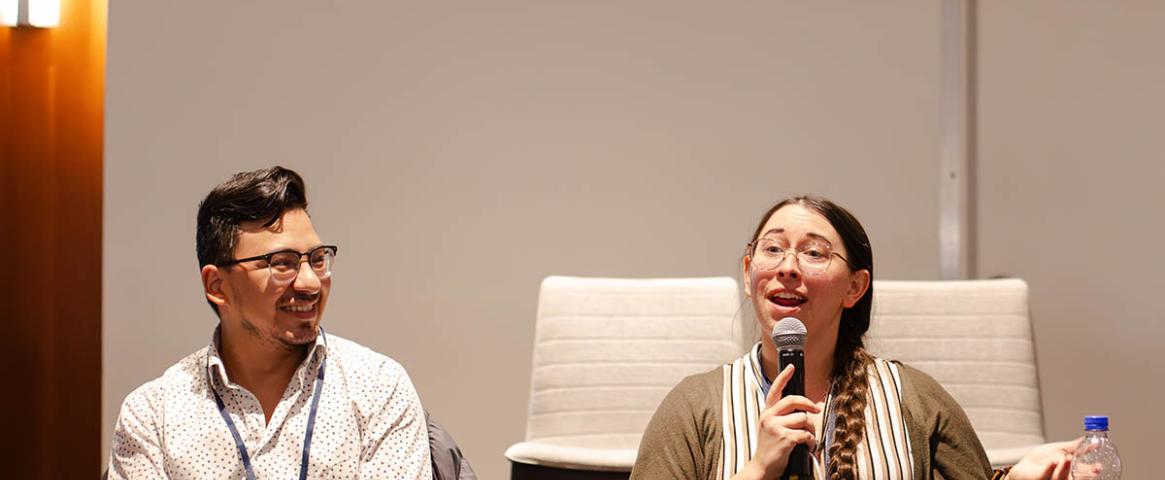Story by Mureji Fatunde
Photography by Sophie Hartley
While the landscape of children’s media is rapidly evolving, the key challenges of being a children’s writer remain largely the same: treating children as fully capable content consumers, and as a diverse group rather than a monolithic audience.
At a recent NASW workshop on writing for children’s media, panelists shared their experience and advice for would-be children’s writers.
"No Kidding: The Truth About Writing for Kids’ Science Media" was held on Nov. 9 in Raleigh, N.C. during the ScienceWriters2024 annual conference. The panel was co-organized by Stephen Ornes, freelance science writer and Writer-in-Residence at Vanderbilt University, and Lindsay Patterson, creator and co-host of Tumble science podcast and CEO of Tumble Media. The event featured four panelists who have worked for print, audio, and television outlets targeting children.
Science by scientists, for all
Ornes set the stage by highlighting the importance and promise of the children’s media market, arguing that children’s curiosity challenges writers to tell stories in new and compelling ways. “There’s no more enthusiastic audience for science than young readers,” he said.
Most of the panelists arrived at children’s science writing from scientific backgrounds. Ainissa Ramirez, author of The Alchemy of Us, leveraged her background as a materials scientist when writing her first children’s book, and is now at work on a series of children’s books that embed substantive scientific content into biographies of scientists. Martín Castillo, an entomologist, conducted research on invasive species at UC Riverside before transitioning into TV writing. Kaitie Janecke Soltesz, a freelance science writer for SciShow Kids and naturalist at Outdoor Discovery Center in Holland, Mich., has a background in ecology and evolutionary biology. Jill Sakai, managing editor of Science News Explores, was trained as a neuroscientist.
There are many reasons to write for children; common goals include satisfying curiosity and contributing to their learning journeys. Ramirez said she was motivated by the opportunity to help children “forge [their] relationship to science” at an early age. Sakai mentioned being driven to help children understand the science behind current events or topics that they might hear about in the news, such as the April 2024 North American solar eclipse.
Multiple panelists mentioned wanting to help children visualize potential career paths in science. However, there was also recognition of the fact that science media is just as important to future non-scientists. Patterson’s transition to working on a children’s series was partly inspired by “the mission of connecting to kids who are not necessarily going to grow up to be scientists and engineers,” she said, adding that she hoped to help children see the relevance of science in their daily lives. Ornes added that nurturing a general understanding of science can spill over into non-science careers and help society: “We want tomorrow’s leaders and politicians and policymakers to understand and employ science in ways that we may see lacking today,” he said.
Not a single group
Panelists highlighted the diversity of children’s audiences, even beyond age group or topic of interest: “ ‘Kids’ is not a specific demographic,” said Patterson. Patterson’s Tumble Media is working on an NSF-funded project to learn how to reach blind and low-vision students who may be excluded when science materials are presented visually. Castillo shared that much of his work is directed at economically disadvantaged children. “I grew up a low-income kid in this country and I feel like there were a lot of limitations in learning… in those spaces,” he said, also citing the stereotypes that children face based on socioeconomic class. “I think this is a beautiful path to…[help them] understand that they can participate in this world no matter their economic standing, race, gender, sexuality… adventurers are adventurers,” said Castillo. Sakai added that writers should be careful about making assumptions about what a child from a certain demographic believes, or the life experiences that they come with.

Kaitie Janecke Soltesz speaks during the "No Kidding" workshop at ScienceWriters2024. (Sophie Hartley for NASW)
Panelists pointed out that children’s writers face the unique challenge of needing to hook a wide audience, rather than fans of a particular genre. “Any child should be able to…enjoy that and find connection in it,” said Soltesz, adding that this differs from the approach to writing for adults, who actively choose which content to engage with.
Furthermore, children’s media must appeal not only to the children themselves, but also to the parents or teachers who show it to them — and perhaps even select it in the first place. “They need to appeal to the adults as well as a massive heterogenous group of children who didn’t necessarily choose it,” said Soltesz. This is true across media: research on podcast listeners has found a high rate of co-listening between kids and parents, caregivers, siblings, and friends, according to Patterson.
What to write, and how
Panelists warned about a key tension inherent in children’s writing: that of meeting young audience members at the level of their understanding without oversimplifying or being overly explanatory. “A really important thing is… to not underestimate the capacity of younger audiences to understand and engage,” said Sakai.
It’s equally important to not make light of serious issues. “There’s commonly an assumption that kids don’t want to deal with heavy issues. Kids deal with heavy issues in their lives; they don’t have a choice about it,” said Sakai, citing topics such as climate change, mental health issues, and the consequences of A.I. advances. Instead of avoiding or downplaying challenging topics, she said, children’s media should help children grapple with and make sense of them.
Curriculum consultants — who typically have experience working in schools — can help writers strike a balance when it comes to complexity, said Soltesz. Sakai added that readability level checkers can evaluate the grade level most closely matched to a piece of content.

Later on Saturday evening, Jill Sakai represented Science News Explores at the "Science Writers for Hire" career networking event at ScienceWriters2024. (Sophie Hartley for NASW)
Mirroring the child’s perspective
While it’s not necessary for kids’ TV or audio shows to feature child actors in order to engage young viewers, the children in the audience must be treated as equals, said Soltesz. “So long as it’s not an adult talking down to a child, the age of the person on the other side of the screen doesn’t necessarily matter,” she said. Some shows achieve this by featuring a fictional character modeled after a child in the target age group, but there are many other options.
“Do you recognize the way that a kid would engage with this?,” asked Patterson. “Is the connection there?”
Panelists concluded the session with practical tips for aspiring or established children’s writers. In the context of TV, Castillo advised writers to identify the “curriculum” or socioemotional layer underlying each episode to help them understand why certain episodes work well. For writers breaking into the industry, panelists encouraged them to take advantage of calls for submissions and find ways to publicly display existing skills. During the Q&A session, Lynn Lamberg, who curates the NASW “Advance Copy” books column, highlighted resources available within NASW, including an email list for those interested in children’s writing.
Soltesz urged audience members to seek exposure to diverse groups of children by visiting libraries or volunteering at schools. “To write good things for children, you have to know kids,” she said. She emphasized that regular interactions — especially informal ones — allow kids to become comfortable sharing unfiltered theories and questions, giving writers unique insight into their mental models of the world.
“Children get… taken into this subcategory where we don’t really appreciate them fully as humans because ‘oh, they’re not done growing yet. They’ll be an adult someday, and [then] they’ll be their full human selves’,” said Soltesz. The key to successful children’s writing involves doing the research needed to find out where they are now — and meeting them there.
Mureji Fatunde (www.mureji.com) is a scientist and writer interested in companies, industries, and consumers. In her research, she uses data to study how organizations make decisions to meet societal and consumer needs. Her writing, which has appeared in Bloomberg, WIRED, and MIT Technology Review, explores science, business, and economic topics through a human lens.
Sophie Hartley (@hartleys.bsky.social @sophienhartley) is a science journalist and photographer from Neenah, Wisc., reporting on land management, natural resources, and rural issues. Her work has appeared in outlets like The Boston Globe Magazine, Science News, bioGraphic, and Science Friday.
This ScienceWriters2024 conference coverage article was produced as part of the NASW Conference Support Grant awarded to Fatunde and Hartley to attend the ScienceWriters2024 national conference. Find more 2024 conference coverage at www.nasw.org
A co-production of the National Association of Science Writers (NASW), the Council for the Advancement of Science Writing (CASW), and the Science Communicators of North Carolina (SCONC), the ScienceWriters2024 national conference featured an online portion Oct. 16-18, followed by an in-person portion held in Raleigh, N.C., Nov. 8-11. Follow the conversation via #SciWri24 on Bluesky and on LinkedIn.
Founded in 1934 with a mission to fight for the free flow of science news, NASW is an organization of ~2,400 professional journalists, authors, editors, producers, public information officers, students and people who write and produce material intended to inform the public about science, health, engineering, and technology. To learn more, visit www.nasw.org and follow NASW on LinkedIn and Bluesky. And join us in celebrating #NASW90th.
Credits: Reporting by Mureji Fatunde; edited by Ben Young Landis. Photography by Sophie Hartley; edited by Ben Young Landis.



